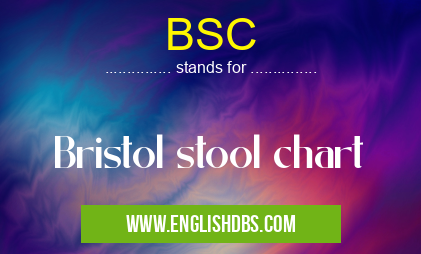What does BSC mean in LABORATORY
The Bristol Stool Chart (BSC) is a visual tool used by healthcare professionals and individuals to assess stool consistency and form. It consists of seven categories, each representing a different type of stool. The BSC is widely used in clinical practice to evaluate gastrointestinal health and identify potential underlying medical conditions.

BSC meaning in Laboratory in Medical
BSC mostly used in an acronym Laboratory in Category Medical that means Bristol stool chart
Shorthand: BSC,
Full Form: Bristol stool chart
For more information of "Bristol stool chart", see the section below.
» Medical » Laboratory
What Does BSC Mean?
BSC stands for Bristol Stool Chart. It is a standardized method for classifying stool consistency and form.
Full Form of BSC
- B - Bristol
- S - Stool
- C - Chart
Uses of BSC
- Assessing gastrointestinal health
- Identifying potential underlying medical conditions
- Monitoring treatment response
- Providing objective data for research studies
Categories of BSC
The BSC categorizes stools into seven types:
- Type 1: Separate hard lumps, like nuts (hard to pass)
- Type 2: Sausage-shaped, but lumpy
- Type 3: Like a sausage but with cracks on its surface
- Type 4: Like a sausage or snake, smooth and soft
- Type 5: Soft blobs with clear-cut edges (passed easily)
- Type 6: Fluffy pieces with ragged edges, a mushy stool
- Type 7: Watery, no solid pieces (entirely liquid)
Interpretation of BSC
- Types 1 and 2: Constipation
- Types 3 and 4: Normal
- Types 5-7: Diarrhea
Essential Questions and Answers on Bristol stool chart in "MEDICAL»LABORATORY"
What is the Bristol stool chart (BSC)?
The Bristol stool chart (BSC) is a visual guide used to classify the form of human feces into seven distinct types, ranging from hard and lumpy to loose and watery. It is widely used by healthcare professionals to assess bowel function and identify potential gastrointestinal issues.
How is the BSC used?
The BSC is typically used by patients to self-assess the consistency of their stools. By comparing the appearance of their stools to the images on the chart, patients can determine their stool type and provide this information to their healthcare provider.
What do the different stool types on the BSC mean?
The seven stool types on the BSC are as follows:
- Type 1: Hard, separate lumps, like nuts (difficult to pass)
- Type 2: Sausage-shaped, but lumpy
- Type 3: Like a sausage, but with cracks on its surface
- Type 4: Like a sausage or snake, smooth and soft
- Type 5: Soft blobs with clear-cut edges (passed easily)
- Type 6: Fluffy pieces with ragged edges, a mushy stool
- Type 7: Watery, no solid pieces, entirely liquid Each type is associated with different digestive patterns and bowel habits.
Is the BSC a reliable tool?
The BSC is a subjective tool, and its accuracy can vary depending on individual interpretations. However, it provides a general indication of stool consistency and can be helpful in identifying potential bowel problems.
When should I use the BSC?
You should use the BSC if you are experiencing changes in your bowel movements, such as constipation, diarrhea, or abnormal stool appearance. It can also be helpful for tracking stool consistency over time to monitor any changes in bowel health.
Final Words: The Bristol Stool Chart is a valuable tool for assessing stool consistency and form. By using the BSC, healthcare professionals and individuals can gain insights into gastrointestinal health and identify potential medical issues. The chart is easy to use and provides objective data that can be used for clinical decision-making and research studies.
BSC also stands for: |
|
| All stands for BSC |
